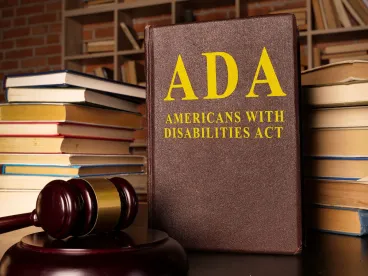For almost two years now, employers have been tackling the issues surrounding COVID-19. Not surprisingly most questions centered on COVID-19-specific leave, OSHA reporting requirements, and vaccines. Now, the EEOC has chimed in on something that employers may not have yet considered: When does an employee’s COVID-19 become a disability under the Americans with Disabilities Act?
Back to ADA Basics
As you know, under the ADA, an employer cannot discriminate against employees with disabilities. Additionally, if an employee with a disability requests a workplace accommodation, you may be required to provide a reasonable accommodation so that the employee is able to perform the essential duties of his or her job.
An employee has a disability if the employee has a physical or mental impairment that substantially limits one or more major life activities. Major life activities include things such as walking, standing, thinking, and other daily activities or bodily functions. Not all of the major life activities involve working. An employee is also considered disabled if the employer regards the employee as having such an impairment or the employee has a record of having such an impairment.
ADA disabilities range from intellectual disabilities to broken bones to diabetes and more, all depending on the circumstances of the impairment. The EEOC has now released guidance on when COVID-19 may become a disability under the ADA, e.g., when its effects substantially limit one or more major life activity of the employee.
The EEOC Guidance
The EEOC’s guidance was published on December 14, 2021. It starts by noting that whether an impairment is a disability is a fact-specific question, dependent on the physical and mental condition of the employee and his or her abilities and restrictions. For example, the guidance notes that a person who is infected with COVID-19 but is asymptomatic, or a person whose COVID-19 results in mild symptoms similar to those of the common cold or flu that resolve in a matter of weeks with no other consequences, will not have an actual disability within the meaning of the ADA. On the other hand, an employee who has symptoms for several weeks or months may be considered disabled, but it is a case-by-case inquiry.
The guidance then notes that COVID-19 is a “mental or physical impairment” because it is a physiological condition affecting at least one bodily system. Thus, the main question becomes whether an employee’s COVID-19 condition “substantially limits” at least one major life activity. The guidance provides a few notable examples of when an employee’s COVID-19 symptoms substantially limit a major life activity:
-
An individual diagnosed with COVID-19 who experiences ongoing and intermittent headaches, dizziness, brain fog, and difficulty concentrating, which the employee’s doctor attributes to COVID-19, is disabled because the employee is substantially limited in the major life activities of brain function, concentrating, and/or thinking.
-
An individual diagnosed with COVID-19 who initially receives supplemental oxygen for breathing difficulties and has shortness of breath, associated fatigue, and other COVID-19-related effects that last (or are expected to last) for several months is substantially limited in respiratory function, and possibly major life activities involving exertion, such as walking.
-
An individual diagnosed with COVID-19 who experiences heart palpitations, chest pain, shortness of breath, and related effects due to COVID-19 that last (or are expected to last) for several months is substantially limited in cardiovascular function and circulatory function.
-
An individual diagnosed with “long COVID,” who experiences COVID-19-related intestinal pain, vomiting, and nausea that linger for many months, even if intermittently, is substantially limited in gastrointestinal function, among other major life activities.
The guidance also provides examples of when an employee’s COVID-19 symptoms do not substantially limit a major life activity:
-
An individual is diagnosed with COVID-19 who experiences congestion, sore throat, fever, headaches, and/or gastrointestinal discomfort, which resolve within several weeks, but experiences no further symptoms or effects, is not substantially limited in a major bodily function or other major life activity, and therefore does not have an actual disability under the ADA. This is so even though this person is subject to CDC guidance for isolation during the period of infectiousness.
-
An individual infected with COVID-19 but asymptomatic is not substantially limited in a major bodily function or other major life activity, and therefore does not have an actual disability under the ADA. This is the case even though this person is still subject to CDC guidance for isolation during the period of infectiousness.
Takeaways
As always, when an employee discloses that she or he has a disability, analyze the specific circumstances and limitations to determine whether the employee’s condition substantially limits one or more major life activities. Generally, meeting this definition of “disability” is not challenging, so err on the side of caution and take each case seriously, considering what, if any, reasonable accommodations may enable the employee to do the essential functions of his or her job. Use the EEOC’s guidance in your analysis, and, as always, get the advice of your legal counsel.





 />i
/>i

